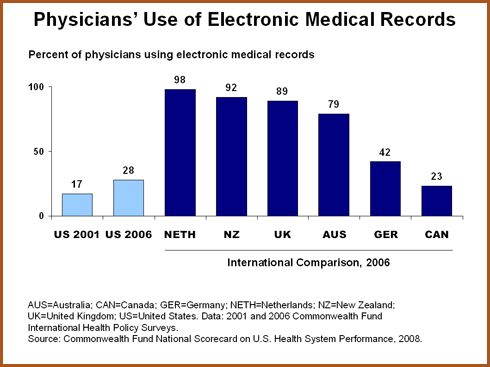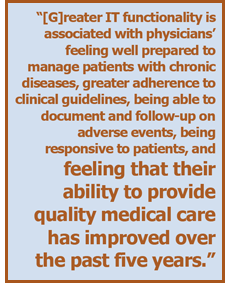Full text is available at:
http://www.sciencedirect.com/science?_ob=ArticleURL&_udi=B6V8X-4V11H9V-1&_
user=10&_rdoc=1&_fmt=&_orig=search&_sort=d&view=c&_acct=C000050221&_
version=1&_urlVersion=0&_userid=10&md5=73aac9799cae03ba04cbf2f534256b99
Synopsis
A survey of 6,536 physicians in seven countries finds that adoption of health information technology (IT) is highly variable, with the United States lagging well behind other countries. Physicians with greater IT capacity were more likely to report feeling well prepared to manage patients with chronic diseases, among other benefits.
The Issue
Advances in health IT are making it easier for physicians to provide coordinated, high-quality care by streamlining many tasks: sending patient reminders, creating disease registries, prescribing and refilling medications, and viewing lab results, among others. Unfortunately, adoption of health IT by physician practices has been slow across countries.

Key Findings
- Electronic medical record (EMR) usage ranges from nearly all physicians in the Netherlands to only 23 percent in Canada and 28 percent in the United States.
- Physicians in the U.S. and Canada, the two countries where EMR use is lowest, reported predictably low use of associated computerized systems. For instance, only 15 percent of physicians in the U.S. and 6 percent in Canada used computerized systems to receive alerts to provide patients with test results.
- In the United Kingdom, 88 percent of primary care physicians can easily generate lists of medications that patients take, including prescriptions from other doctors, compared with only 37 percent of doctors in the U.S. The ability to generate medication lists promotes coordination of care among doctors and can help prevent medication errors.
- Over three-quarters (78%) of primary care physicians with high IT capacity felt well prepared to care for patients with multiple chronic diseases, compared with only 66 percent of physicians with low IT capacity.
- There is a strong relationship between IT capacity and patient safety: the greater the capacity, the more likely a practice has a patient-safety system in place. More than two of five (43%) physicians with high IT capacity had a process for dealing with adverse events, compared with 27 percent of practices with low IT capacity.
- Thirty-one percent of primary care physicians with high IT capacity and 28 percent of those with medium IT capacity reported their ability to provide quality medical care had improved over the past five years. By contrast, just 22 percent of those with low IT capacity reported similar views.
Addressing the Problem
 Federal leadership in the U.S. may be required to accelerate IT adoption among physician practices. In England, for example, the federal government has established standards, and has financed and implemented IT tools; as a result, nearly all physicians there have EMR systems and a great majority report high IT capacity. The U.S., which has been slow to adopt standards and has not made a financial commitment to IT, lags behind all of the study countries, except Canada. Additional IT system development is needed in nearly all countries, particularly to enable the linking of patient information across sites of care. When physicians cannot access hospital records, transitional care can be undermined, sometimes resulting in costly re-hospitalizations.
Federal leadership in the U.S. may be required to accelerate IT adoption among physician practices. In England, for example, the federal government has established standards, and has financed and implemented IT tools; as a result, nearly all physicians there have EMR systems and a great majority report high IT capacity. The U.S., which has been slow to adopt standards and has not made a financial commitment to IT, lags behind all of the study countries, except Canada. Additional IT system development is needed in nearly all countries, particularly to enable the linking of patient information across sites of care. When physicians cannot access hospital records, transitional care can be undermined, sometimes resulting in costly re-hospitalizations.
About the Study
Data was obtained from the 2006 Commonwealth Fund International Health Policy Survey of Primary Care Physicians, which involved 6,536 physicians in seven countries: Australia, Canada, Germany, the Netherlands, New Zealand, the U.K., and the U.S. The researchers created an IT measure of 14 capabilities, including use of EMRs, routine electronic ordering of tests, and computerized systems for patient reminders. Physicians were considered to have "low" IT capacity if they reported two of the 14 items, "middle" capacity if they reported three to six items, and "high" if they reported seven to 14 items.
The Bottom Line
Despite evidence that IT can improve the quality and safety of care, adoption of health IT systems by physician practices has been slow and variable across countries.
